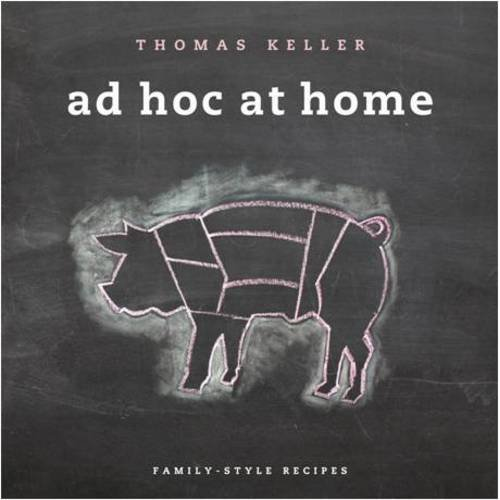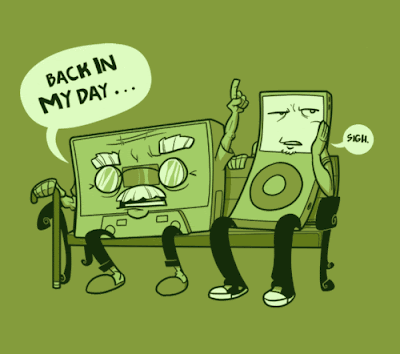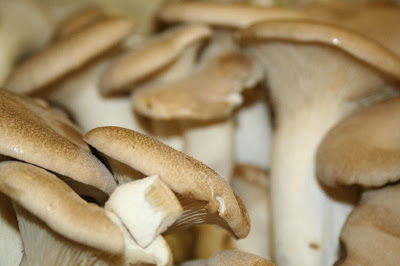Years ago I decided to carve a cityscape in my pumpkin instead of a face. Try something different with your pumpkin this year and think outside the gourd. Happy Halloween!
Saturday, October 31, 2009
Wednesday, October 28, 2009
AD HOC AT HOME
Thomas Keller has made a very successful career out of cooking with the absolute best ingredients, using the finest, most disciplined technique and maintaining a work ethic that at times doesn't seem human. Legions of cooks and chefs follow his every move as he personifies excellence in cooking. His name is synonymous with perfection. He has arguably influenced more professional cooks than any other chef working in the country today. How long can you sustain that? When is it time to exhale? And, can he, will he ever do a cookbook for the average man?
Ad-Hoc at Home is that book for Thomas Keller.
If The French Laundry cookbook was Keller's ground breaking bible on how to make the most precious, perfect cuisine, and Bouchon was his paean to French country cooking, and Sous Vide Cooking showed his expertise for cooking with a technique, not new to the French, but is taking finer establishments by storm on this side of the Atlantic, then with Ad-Hoc at Home he is ready to truly bare his soul as a cook.
When you open this book for the first time (equally beautiful in design and rich with painterly images of food as any of his other books), you can't help notice the copious pictures of Chef Keller playfully smiling and relaxed. The book is laid out in categories of foods and with lessons on how to prepare them for anyone who wants to learn them. The Laundry was just the same, and for that matter, so are the others. Keller can't help doing what he does best: teach. His lessons are succinct and relevant. They aren't tips for cooks- they are concepts. Building blocks. Miss one, and you don't stand a chance of ever getting the most out of his recipe or lesson. And his overall lesson is this: "Great product + great execution = great cooking."
I won't cimb up in my ivory tower for this next bit, but at my alma mater, The Culinary Institute of America, whose motto is "preparation is everything", they prepare you to leave their vaunted halls being able to cook absolutely anything. How much you paid attention, how hard you worked, how much you compromised and how much you were willing to sacrifice determined whether or not you could avail yourself of those lessons later in life. Keller never attended culinary school. Part of the legend of Thomas Keller is how much he's achieved without formal training. But, it just goes to show the power of the human mind and what you can achieve. Those aren't culinary lessons, they are life lessons.
And so, it seems appropriate that Ad Hoc combines this philosophy of striving for excellence with a passion for preparing (and eating) the finest tasting food possible.
For those who have read and keep his other books on their own shelf, you'll be pleasantly surprised to see the more human side of Keller. A CUPCAKE in a Thomas Keller cookbook?? And not a play on words, like Gateau St. Honore cooked in a porcelain coffee cup bain marie with carefully quenelled butter cream icing on a demi-tasse spoon. I mean plain, no doubt insanely delicious, but simple, white cupcakes. His Buttermilk Fried Chicken has just seven ingredients. If you are a lover of salads, he offers about 10 classics that are both pronounceable and can be prepared for your mom and dad. In other words, salad. Salads. It's a salad. It's. Salad.
If you learned how to properly and humanely snap the neck of a rabbit in French Laundry, he takes a kinder, gentler approach in Ad Hoc for getting extra meat out of lobster, breaking up a head of garlic and rolling out dough for soup crackers, all with a rolling pin.
Did I mention the smiling? It really is something. For those who don't understand what a break this book is from his past, it is like sharing a beer with your pastor- when you're 16. He may be the only 3 Star Michelin chef with a recipe for broccolini. Yes- that hybrid veggie you snub your nose at in the grocery store. This is one cookbook that's going to get dirty. You should plan on getting either a cover for it, a cookbook stand or both. Once you see it, read it, and cook out of it, you'll find yourself buying it for your favorite cook.
What makes this cookbook so special is what it is not. It is not pretentious. It is not precious. It is not to be put on a pedestal. You can pick up Ad Hoc not having read any of Keller's other books or even know who he is, and you will find yourself an instant fan. For the seasoned pro, the delight will be in revisiting all the Keller commandments of cooking, but with a much less authoritative tone. He still begs you to get rid of your tongs and stop manhandling your food. He wants you to really understand the importance of salt. And he restates his love for eggs, as they turn up in various recipes and diverse preparations.
When you read the first chapter about Keller connecting with his estranged father after years and years, you'll understand the inspiration for a book and restaurant that is about generosity, of food, of portions, of spirit. When you understand that Thomas was raised by his mother and considers her one of his mentors, you'll see why this feels like a final chapter on the Book of Keller.
The Chef cooked his father's last meal for him the night before he passed away. After he did so, he says a lightbulb went on. The book is laced with "lightbulb" moments, or good ideas; the first sums up how he may have come to such an epiphany that could easily be the theme of his book:
"The first lightbulb moment I want to offer is one I was lucky to realize in time, and hope that others will, too. It may seem obvious but it's worth repeating: Take care of your parents."
I've shared more meals with my parents than with probably anyone else. My life is rich with memories of cooking and eating with them and the rest of my immediate and extended family, and loved ones. "Obvious", yes. Common, know.
I've yet to cook one recipe out of this book. I haven't even had it for more than 24 hours. But already, I feel a closer connection to this chef who has at times seemed like a deity. I suppose it's like meeting your idol and finding that they're just like you. And with all their frailties, they're human, too.
On page one of the Introduction, last paragraph, just before you take the dive into Ad Hoc at Home, Keller makes one last honest gesture to take any fear out of using this book:
"When we eat together, when we set out to do so deliberately, life is better, no matter your circumstances. Whether it's a sad or difficult time, whether it's an ordinary-seeming day, or whether it's a time of celebration, our lives are enriched when we share meals together. And that's what this book is about."Thank you, Chef.
Monday, October 26, 2009
The Top 10 Best Trends in Dining This Decade
Last week a friend sent me a link to a recent article in the Chicago Tribune listing the 10 most egregious food trends over the last decade. It didn't really hit me until after I read the piece that we are fast approaching the end of another decade! So with all the crazy end-of-decade special edition magazines, newspaper columns, and radio countdowns, I thought I might contribute a list of my own to the blogosphere.
I've always been a list guy. Cooks thrive on them, chef's live and die by them. But, if The Trib was going to diss the culinary community for the 10 things they found most annoying about this decade, I thought it only appropriate to offer my glass-half-full view of things. And so, here is my
Top 10 Most Significant Advances in Dining in This Decade!
Disclaimer: understand that as a rule, I consider "significant" to mean a tipping point for the trends listed below. Most of them didn't start in the last ten years. Yet, they came into the mainstream consciousness this decade, and thereby survived the fad faze and became a sustained trend making them significant in the way we think about food and dining today.
1. No Smoking!
While many restaurant owners voluntarily banned smoking in the early 90's (and I consider them brave pioneers with vision), only in the last decade have we seen whole statewide and metropolitan bans on smoking in public places. Not just white table cloth restaurants, but chain restaurants, sub shops and bars. Let me say it again, 10 years ago, when you were being seated in a restaurant, it was commonplace to be asked, "smoking or non-smoking?" Even as a reformed smoker, it seems arcane to me we tolerated such an assault on our senses as we paid good money to eat a meal in a cloud of second hand smoke. Yet, to date, there are only 24 states that have enacted bans on smoking in all public places, including restaurants and bars. However, in 60 of the most populated cities in the United States, only 19 have not enacted some sort of ban on smoking in public places (Philadelphia is one of them). So, while we still have a ways to go, the clearing of cigarette smoke from the public dining room gets my vote for significant advancement in dining in the last 10 years, nonetheless.
2. The Ipod "What?" Indulge me. As a former front of house manager, restaurant owner, musician, dj and audiophile, the advent of the Ipod was nothing short of achieving warp drive in space travel. You can differ if you like, that's the whole point. But, I argue that between skipping cds, horrible canned muzak, repeating artists or albums, erratic volume levels and non-sequitur playlists, the Ipod as dining enhancement was huge. Many people take for granted two key aspects of dining: lighting and music. Often, both are subliminal, but when music is given equal consideration with things like color choices and linens, it helps contribute to a complete dining experience worth remembering. Suddenly we were able to quickly and effectively control an important element of luring guests and keeping them at our restaurants and bars. And so, the Oscar for best supporting role in a dining experience goes to: The Ipod from Apple. Runner-up: Satellite radio.
3. Proliferation of Ethnic Cuisines
I used to think that people who talked about "this awesome Afghani restaurant" they went to were just trying too hard to be cool. But, there is no question that when I get the infamous "Where do you like to dine?" that comes with being a chef, my top 5 answers are always ethnic cuisines. Hey, don't get me wrong; I love my good all-American dishes of bbq, meatloaf and fried chicken, but variety is the spice of life, baby, and in the last decade, things got a lot more diverse in the country we aptly call the cultural melting pot. With this trend also comes the "win-win" of being able to find the ingredients that make up these marvelous foods in an accessible grocery so we can enjoy them at home. That can only mean that more and more people are finding a comfort level with foods they'd not had before. Which brings me to my next choice...
4. The 21st Century Grocery
Wegmans and Whole Foods have been around for decades, and many American's take full advantage of their in-house, fresh preparations of take-home foods and a multitude of high-quality products they offer. But, it's the popularity of these types of stores that made the average frumpy grocer have to shape up, or ship out. The competition got a lot more competitive in the last 10 years, and so cleaner, more diverse stores rose from the ashes of The 70's and 80's, when supermarkets were about sheer quantity and not quality. The 80's and 90's saw the addition of the Exotic Foods aisle (which cracks me up, still). You'd walk down and see lentils and jasmine rice with La Choy Fried Noodles and extra-virgin olive oil and be like, "This isn't exactly my idea of a trip through the spice markets of Marrakesh." In the last 10 years, the bar was raised on how and where we shopped, because the bar was raised on how and what we ate.
5. Ferran Adria
At the end of 1998, I had just graduated from the CIA and finished a brief externship in Biarritz, France. While I was there, I had heard from cooks about an amazing chef who was winning all sorts of praise in Europe. The odd thing was that he was Spanish, not French. By the end of 1999 The Wallstreet Journal had published an article about the little known Ferran Adria and his temple of experimental cuisine, El Bulli. I thought it was cool that he'd been mentioned, but I didn't really expect the impact on American dining that would follow from this exposure. And suddenly, the dubious FOAM began to make its way onto the plates of finer restaurants all over the country. Foam was on The Tribune's grumpy list, but it became the most imitated technique Adria helped spawn in an era when cooks began looking at cooking from a scientist's point of view. I wholeheartedly give props to Adria for steering a complacent American dining scene in a direction that made everyone from the highest praised chef down to the hard-hitting line-cook rethink the way food can be prepared and perceived.
6. Riches-to-Rags-to-Rebirth of The James Beard Foundation
As a chef it had always been a personal goal of mine to be asked to cook at the JBF. When I did so in March of 2003, it was an exhilarating, but very humbling experience. I could look at the success of the dinner not as something to put on a resume but an experience that changed my life and my direction as a chef. So, to receive an award for excellence or even be nominated for an award by the Beard Foundation was the pinnacle for nearly all American chefs.
Yet, one year later in September of 2004, scandal rocked the Beard Foundation as the New York Times reported the prestigious non-profit hadn't filed tax returns for two years. Its president had been accused of helping himself to hundreds of thousands of their tax-free dollars. It was the culinary equivalent of the steroids scandals that mar the great game of baseball, even today. To chefs who had cooked there or aspired to do so, it was a huge blemish on all that was sacred in the JBF. And so, a sullied Beard House saw the resignation of its entire Board of Directors the following January. An interim board was appointed to oversee the restructuring of this revered institution.
With renewed vision, the James Beard Foundation climbed its way out of the mud and today, once again, takes its place in the hearts of industry professionals as The Carnegie Hall of the culinary world.
7. The Locavore Movement
Sad that it took a film about the degradation of the earth's atmosphere for the one of the largest grossing private industries in America to realize its time had come to grow up. And so with Al Gore's An Inconvenient Truth, we saw the green movement explode into a whole new era of social awareness that focused on how we eat, to how it may be harming our environment, to the incredible shrinking farms our super-sized economy helped stamp out. "Carbon footprints" and "sustainability" entered our vocabularies. Suddenly, for chefs who all along knew that much of their success depended wholly on the quality of their ingredients, it got a lot easier to shine when local farmers started knocking on the kitchen doors of these low-profile chefs who felt a connection with their new soul mates, the local farmers. Farming hip? Stupid that it should have come to that, but there it is; local, fresh and seasonal is as common today as crab imperial, veal Oscar and steak au poivre was 40 years ago.
8. The Internet
"The Internets", as W called it, isn't new to this decade. But, just ten years ago, if you didn't have a website for your restaurant, it wasn't a big deal. It was usually for the new kids on the block who were showy and didn't have the chops to hang with the old boys. Or so it seemed. Today, if you can't find a website for a restaurant, it's assumed they haven't opened yet, or they've already closed.
The Online Knee-Jerk Restaurant Review took it on the chin from the Tribune in their list. When Citysearch cropped up and began getting a whole new community of people in search of the latest on the hottest dining spots, the tide turned, and for good or bad, prevalent online comments and reviews helped get the word out as no other form of free marketing for restaurants could.
The Open Table reservation system started making it more acceptable to make dining reservations online and they rewarded their users for doing so. Operators jumped on it because it was the most efficient form of demographics tool that ever existed in the restaurant business. It's literally a culinary concierge. That's because the company is owned and run by former restaurant people and its software designed by former soldiers of hospitality.
With the first decade of the internet fully integrated into our lives and industry, it seems natural, for example that we completed simple tasks like ordering food and beverage online, both as operators and customers. Spelling checks and Wiki-searches help a restaurant look smarter by avoiding erroneous references, one of my pet peeves. And thick, out of date product catalogs were replaced with PDF files that saved loads of time, reams of paper and allowed for restaurants to stay more current.
Finally, I include blogging in this category, because when a site like Foodie Blogroll, for example, boasts 5000 different blogs to date, all dedicated to the love of food, it's no longer a fad, it's a trend. Sure, that's a lot of opinions, but there is an equal amount of passion among food and wine bloggers. And there tends to be a lot more honesty in writing when the survival of a blog isn't dependent on revenue. (At least, not yet, anyway.) It may have been partially responsible for the death of Gourmet Magazine, but such is change.
9. Culinary Crusaders
 When I saw the film Supersize Me! it made me physically ill. Morgan Spurlock's project of eating nothing but food from McDonald's for 30 days and nights was a much needed wake-up call for a super-sized America. His health deteriorated right before our very eyes just from maintaining a steady diet of the world's most popular fast food. Simply put- had he continued his experiment, it would have killed him.
When I saw the film Supersize Me! it made me physically ill. Morgan Spurlock's project of eating nothing but food from McDonald's for 30 days and nights was a much needed wake-up call for a super-sized America. His health deteriorated right before our very eyes just from maintaining a steady diet of the world's most popular fast food. Simply put- had he continued his experiment, it would have killed him. Blue Hill chef Dan Barber began to flex his prodigious talent as a writer and helped bring awareness to growing the Farm to Table movement. Blue Hill in Pocantico Hills, New York became a model for full sustainability in a restaurant. Frequent editorials in the Opinion pages of the New York Times gave the little guys in farming and community supported agriculture (csa) programs the much needed attention it took to make three of the previously mentioned trends possible.
And, then there's Michael Pollan. Pollan's The Omnivore's Dilemma and In Defense of Food also got early exposure on the pages of the Times, but soon these writings became required reading for a new generation of cooks and chefs who felt more connected to the earth than The Food Network. Best sellers, these books questioned not just what we ate, but how much and where it came from. He made us stare long in the mirror about where we were headed as a nation and the way we ate.
10. The Food Network.
It's the one I love to hate. It's become such an integral part of how we are entertained, how we view the profession of cooking, how we cook at home, what we buy, what we eat, and how we entertain. I've made it known I'm not a fan of The Food Network, but like it or not, in the last 10 years, they've been one of the largest influences on dining industry in the US. Now if we could only get them to see the previous 9 items.
Labels:
history,
Pop Culture,
trends
Wednesday, October 21, 2009
A Fungi to Be Around: UPDATED
Below are some photos of the final dishes from last night's mushroom dinner. Thanks to everyone for joining us and sticking around to route the Phillies on to another pennant title!!Yesterday we began putting things together for tonight's Mushroom dinner. I always get excited when product starts to arrive for these dinners. And yesterday the kitchen was burning on all cylinders to get ready. Here are some shots of a work in progress to get you excited, too.
Some perspective on what 10 pounds of wild maitake's look like.

Gorgeous chicken of the woods, also wild. These, along with the stems from maitake's make up the first course soup: chestnut and mushroom bisque with mapled double-smoked bacon

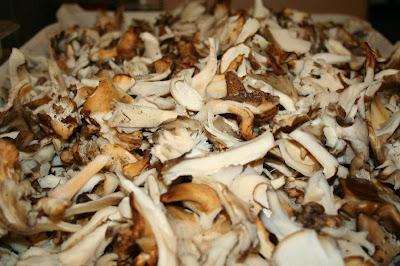
More maitakes, cleaned and ready for roasting. The aroma was nothing short of dizzying.

These are the feathers, or gills of portobello mushrooms. When dried, they bare a strong resemblance to truffles. We'll use them in the sauce for the lamb sirloin.
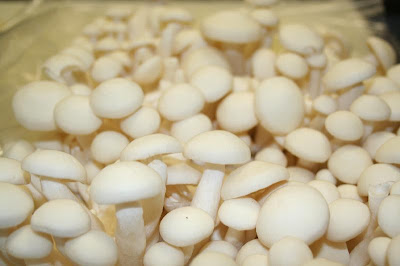
Beech, Royal Trumpet and Shiitakes

Royal trumpets get a roasting for the lasagnette, along with beech and maitakes.
Building the lasagna.
A robiola bechamel with hand-packed sheep's milk ricotta and fresh herbs binds the layers together.
Layer 2
Final layer #3
Into the oven and...
Finito!
Pumpkin creme brulee waits for its caramelly, crunchy top.
Today, we'll be working on the lamb sirloin with Brussels sprout leaves and truffle demi-glace. Also, the hors d'oeuvres of portobello satay, lobster and sausage stuffed crimini mushrooms and shiitake spanakopita.
These dishes are paired with the Spanish portfolio of Jorge Ordonez wines, including rose, rioja blanco, tempranillo, monastrell, old vines grenache and muscat.
Shiitake spanakopita was filled with feta and sauteed spinach
Portobello satays marinated for 24 hours and then were grilled and served with a horseradish cream


chestnut and chicken of the woods bisque with maple double-smoked bacon
The finished three mushroom lasagnette with robiola.

Sirloin of Lamb with rosemary and Brussels sprout leaves was heaped with black truffles

Pumpkin creme brulee
The wines were all dynamite with the courses. Thanks to Kevin Malarkey from the Country Vintner and the crew from Frank's Union Wine Mart!
Labels:
local eats,
mushrooms,
photos,
wine dinners
Tuesday, October 20, 2009
Subscribe to:
Comments (Atom)

